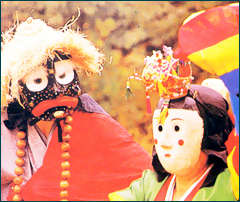| PDF Service | Korean | Japanese | Chinese |
|
|||||||
|
Korean folk dances show how the wise overcome reality
 oreans are people who are full of excitement and when they are having fun they dance naturally, moving their shoulders. There are many kinds of traditional Korean dances and Talchum is one of them. Talchum is a mask dance accompanied by songs that pass on wisdom to help overcome the tiredness of reality.
oreans are people who are full of excitement and when they are having fun they dance naturally, moving their shoulders. There are many kinds of traditional Korean dances and Talchum is one of them. Talchum is a mask dance accompanied by songs that pass on wisdom to help overcome the tiredness of reality.
The History of Talchum Some Koreans' ancestors lived an unfair life ruled by an unrelenting upper class. Peasants and farmers spoke of their plight and the wrongdoings committed by the ruling class, the Yangban, in mask dances. They criticized the upper class through lyrics in the Talchum and since the people were not punished for doing this, they were granted a sort of freedom of speech while dancing and acting in the Talchum. The participants of the dance criticized the hierarchial society, the apostate monks, and the violence of man. The main characters of the Talchum are the upper class, monks, and peasants, who made fun of rich aristocrats. The popular versions of Talchum that have been passed on to the present day are the Songpa Sandaenori, Yangju Byeolsan Daenori, Bongsan Talchum, Gangnyeong Talchum, Goseong Ogandae, and Hahoebyeol Shingutnori. Representative Talchum There are about thirteen different types of Talchum that have been passed down the ages. Among those, the Bongsan Talchum and Songpa Talchum are most well-known. The Songpa Talchum was handed down to the Songpa area in south east Seoul though Kyonggi Province. Songpa Talchum settled in the area about 200 years ago and at that time it was performed on traditional Korean holidays, such as the Jeongwol Daeboreum (first full moon of the lunar calendar), Dano, and Chusok. The Bongsan Talchum was passed on from the Haeseo area and was performed in May. Talchum is an important Korean cultural inheritance that contains the thoughts of the Korean people of the past, but still depicts the reality of human life in a realistic manner. The most attractive characteristic of Talchum is the unity created between the characters and the audience. Korean Masks The masks show a sharp resemblance of the Korean people's facial expressions, their appearances, and also the individual characters of each person appearing in the Talchum. The carvings on the masks for the Seonbi (scholar), Yangban, bride, monk, Baekjeong (butcher) of the Hahoe masks are masterpieces. The masks are now a popular souvenir item among tourists because they reveal the Korean people's sentiment to a perfection. Place to See All Types of Traditional Korean Masks The National Folk Museum (734-1346/720-3137)'s exhibition hall number 3. To get there by subway, exit number 5 of the orange line number 3 at Gyeongbokgung station, or exit number 1 of the green line number 2 at Anguk station, or exit number 2 of the purple line number 5 at Gwanghwamun station. From the airport, take the purple line number 5, get off at Gwanghwamun station, or get off in front of the Koreana hotel when using the airport shuttle bus, or get off in front of the Donghwa Duty-Free Shop when taking buses number 63 or 1002 from the airport to downtown Seoul. (Sourced from WHAT'S ON SEOUL) |
|
||||||||||||||||||||||||||||||||||||||||||||||||||||||||||||||||||
|